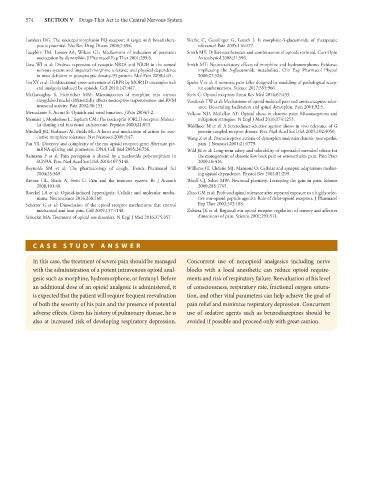Page 588 - Basic _ Clinical Pharmacology ( PDFDrive )
P. 588
574 SECTION V Drugs That Act in the Central Nervous System
Lambert DG: The nociceptin/orphanin FQ receptor: A target with broad thera- Skarke C, Geisslinger G, Lotsch J: Is morphine-3-glucuronide of therapeutic
peutic potential. Nat Rev Drug Discov 2008;7:694. relevance? Pain 2005;116:177.
Laughlin TM, Larson AA, Wilcox GL: Mechanisms of induction of persistent Smith MT: Differences between and combinations of opioids revisited. Curr Opin
nociception by dynorphin. J Pharmacol Exp Ther 2001;299:6. Anaesthesiol 2008;21:596.
Liaw WI et al: Distinct expression of synaptic NR2A and NR2B in the central Smith MT: Neuroexcitatory effects of morphine and hydromorphone: Evidence
nervous system and impaired morphine tolerance and physical dependence implicating the 3-glucuronide metabolites. Clin Exp Pharmacol Physiol
in mice deficient in postsynaptic density-93 protein. Mol Pain 2008;4:45. 2000;27:524.
Liu XY et al: Unidirectional cross-activation of GRPR by MOR1D uncouples itch Spahn V et al: A nontoxic pain killer designed by modeling of pathological recep-
and analgesia induced by opioids. Cell 2011;147:447. tor conformations. Science 2017;355:966.
McGaraughty S, Heinricher MM: Microinjection of morphine into various Stein C: Opioid receptors Annu Rev Med 2016;67:433.
amygdaloid nuclei differentially affects nociceptive responsiveness and RVM Vanderah TW et al: Mechanisms of opioid-induced pain and antinociceptive toler-
neuronal activity. Pain 2002;96:153. ance: Descending facilitation and spinal dynorphin. Pain 2001;92:5.
Mercadante S, Arcuri E: Opioids and renal function. J Pain 2004;5:2. Volkow ND, McLellan AT: Opioid abuse in chronic pain: Misconceptions and
Meunier J, Mouledous L, Topham CM: The nociceptin (ORL1) receptor: Molecu- mitigation strategies. N Engl J Med 2016;374:1253.
lar cloning and functional architecture. Peptides 2000;21:893. Waldhoer M et al: A heterodimer-selective agonist shows in vivo relevance of G
Mitchell JM, Basbaum AI, Fields HL: A locus and mechanism of action for asso- protein-coupled receptor dimers. Proc Natl Acad Sci USA 2005;102:9050.
ciative morphine tolerance. Nat Neurosci 2000;3:47. Wang Z et al: Pronociceptive actions of dynorphin maintain chronic neuropathic
Pan YX: Diversity and complexity of the mu opioid receptor gene: Alternate pre- pain. J Neurosci 2001;21:1779.
mRNA splicing and promoters. DNA Cell Biol 2005;24:736. Wild JE et al: Long-term safety and tolerability of tapentadol extended release for
Reimann F et al: Pain perception is altered by a nucleotide polymorphism in the management of chronic low back pain or osteoarthritis pain. Pain Pract
SCN9A. Proc Natl Acad Sci USA 2010;107:5148. 2010;10:416.
Reynolds SM et al: The pharmacology of cough. Trends Pharmacol Sci Williams JT, Christie MJ, Manzoni O: Cellular and synaptic adaptations mediat-
2004;25:569. ing opioid dependence. Physiol Rev 2001;81:299.
Rittner HL, Brack A, Stein C: Pain and the immune system. Br J Anaesth Woolf CJ, Salter MW: Neuronal plasticity: Increasing the gain in pain. Science
2008;101:40. 2000;288:1765.
Roeckel LA et al: Opioid-induced hyperalgesia: Cellular and molecular mecha- Zhao GM et al: Profound spinal tolerance after repeated exposure to a highly selec-
nisms. Neuroscience 2016;338:160. tive mu-opioid peptide agonist: Role of delta-opioid receptors. J Pharmacol
Scherrer G et al: Dissociation of the opioid receptor mechanisms that control Exp Ther 2002;302:188.
mechanical and heat pain. Cell 2009;137:1148. Zubieta JK et al: Regional mu opioid receptor regulation of sensory and affective
Schuckit MA: Treatment of opioid use disorders. N Engl J Med 2016;375:357. dimensions of pain. Science 2001;293:311.
C ASE STUD Y ANSWER
In this case, the treatment of severe pain should be managed Concurrent use of nonopioid analgesics including nerve
with the administration of a potent intravenous opioid anal- blocks with a local anesthetic can reduce opioid require-
gesic such as morphine, hydromorphone, or fentanyl. Before ments and risk of respiratory failure. Reevaluation of his level
an additional dose of an opioid analgesic is administered, it of consciousness, respiratory rate, fractional oxygen satura-
is expected that the patient will require frequent reevaluation tion, and other vital parameters can help achieve the goal of
of both the severity of his pain and the presence of potential pain relief and minimize respiratory depression. Concurrent
adverse effects. Given his history of pulmonary disease, he is use of sedative agents such as benzodiazepines should be
also at increased risk of developing respiratory depression. avoided if possible and proceed only with great caution.

